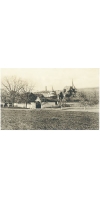Wine from Robert Weil

SIR SUTTON'S LEGACY A WEALTHY PATRON OF THE ARTS BY THE NAME OF SIR JOHN SUTTON FIRST ARRIVED IN KIEDRICH IN 1857. HE FELL IN LOVE WITH THE TOWN FOR ITS LANDSCAPE AND CHARACTER, INCLUDING THE GOTHIC ST. VALENTINUS CHURCH, ITS VARIOUS NOBLE ESTATES AND THE RUINS OF SCHARFENSTEIN CASTLE. SUTTON DIED IN 1873, AND DR. ROBERT WEIL ACQUIRED HIS MANOR AND SETTLED IN KIEDRICH TWO YEARS LATER
WHILE PRIMARILY ENGAGED AS A JOURNALIST, DR. ROBERT WEIL ALSO BEGAN EXPANDING HIS WINE HOLDINGS THROUGH THE ACQUISITION OF SOME OF KIEDRICH'S FINEST HILLSIDE SITES. HIS UNCOMPROMISING DEDICATION TO QUALITY IN THE VINEYARD PROVED PROPHETIC AND LED TO THE RAPID DEVELOPMENT OF THE ESTATE AND AN INTERNATIONAL AUDIENCE FOR HIS WINES.WELCOME AT ANY TABLE
AS THE WHITE COUNTERPART TO THE GRAND RED WINES OF BORDEAUX, THE RIESLING AUSLESEN FROM WEINGUT DR. WEIL HISTORICALLY GRACED THE TABLES OF MANY OF EUROPE'S NOBLE AND IMPERIAL HOUSES
WEIL'S RIESLINGS WERE FAVORITES NOT JUST OF THE ARISTOCRACY, BUT ALSO OF THE PROSPERING MIDDLE CLASS. AUSLESE WINES FROM THE KIEDRICHER BERG WERE REGULARLY FEATURED IN BERLIN'S HOTEL ADLON AND THE WINE LISTS OF OTHER GRAND METROPOLITAN HOTELS. A 1920 KIEDRICHER GRÄFENBERG TROCKENBEERENAUSLESE BESTES FASS NR. 20 FROM DR. WEIL'S ESTATE ENRICHED THE WINE LIST OF THE "LZ 127 GRAFZEPPELIN" AIRSHIP ON ITS MAIDEN VOYAGE IN 1928 TO NEW YORK.HIGH SOCIETY
THE SON OF THE ESTATE'S FOUNDER, ATTORNEY DR. WILHELM WEIL, ASSUMED THE HELM IN 1920. BEYOND HIS INVOLVEMENT WITH POLITICAL ISSUES AFFECTING WINEGROWERS — THE ESTATE HAS BEEN A MEMBER OF THE VDP AND ITS PREDECESSOR ORGANIZATIONS SINCE 1907 — HE ALSO SUCCESSFULLY NAVIGATED THE ESTATE THROUGH DARK AND TURBULENT TIMES. STARTING IN THE 1950S, HIS WINERY REATTAINED ITS STATUS AS A POPULAR DESTINATION FOR WINE CONNOISSEURS.
DR. WILHELM WEIL'S SON ROBERT, ALSO AN ATTORNEY, WAS NEXT TO ASSUME THE REINS TO THE ESTATE. STARTING WITH THE FAMOUS 1959 VINTAGE, HE RETURNED RIESLINGS FROM THE KIEDRICH VINEYARDS TO THEIR PREVIOUS PROMINENCE BOTH IN GERMANY AND AROUND THE WORLD.
ONCE UPON A TIME, THE VISION AND ENTREPRENEURIAL COURAGE OF DR. ROBERT WEIL PROVED ESSENTIAL TO THE SURVIVAL OF THE ESTATE. AFTER ALL, HIS PRIVATELY OWNED WINERY HAD TO STAY AFLOAT IN A SEA OF NOTABLE RHEINGAU ESTATES WITH DEEP-ROOTED TIES TO THE CHURCH OR ARISTOCRACY. HIS GREAT-GRANDSON WILHELM WEIL HAS CARRIED THAT BOLD APPROACH INTO MODERN TIMES.
Wilhelm Weil learned the intricacies of winemaking from the ground up. That education has shaped the many decisions that now define the fortunes of the estate. His efforts began in 1987 with far-sighted investments in the cellar and vineyards and the introduction of the "Tiffany Blue" label. As the founder's great-grandson, there is real pride in the global attention being accorded once again to Weil Rieslings.
EACH WEIL RIESLING EXPRESSES A SIMULTANEOUS ELEGANCE AND COMPLEXITY ORIGINATING IN THE DISTINCTIVE, STONY CHARACTER OF THE KIEDRICH HILLSIDES. THE WEIL STYLE, HOWEVER, HAS DONE MORE THAN JUST EARN INTERNATIONAL RECOGNITION FOR THE ESTATE. IT HAS ACHIEVED A SYMBOLIC STATUS ON THE WORLD STAGE AND HELPED RAISE THE INTERNATIONAL PROFILE OF GERMANY’S UNIQUE RIESLING CULTURE.
No products found
- back
Selected Options
Wineries
Categories
Pricing
Countries
Regions
Grape Types
Wineries
Organic/Free Shipping
Aromatically the wine lifts from the glass with a combination of perfectly ripened red and black fruits, with a graphite smokiness and a hint of mulling spices. On the palate, their is a youthful tannic structure and a floral flavors alongside the fruity notes.
Spicy cologne lifts from the 2021 Pinot Noir Paul Gerrie Vineyard, with both high-toned and darker notes of sage, menthol, bergamot, and cranberry cocktail. Medium to full-bodied, it’s tightly coiled, with tremendous length, gripping ripe tannins, a bright spine of acidity, and mouthwatering salinity that lasts long on the finish. It offers up great mineral texture and will need 3-5 more years in bottle.
- Jeb Dunnuck 96 Points
Trione Pinot Noir River Road Ranch is made from 100 percent Pinot Noir.
River Road Ranch encompasses 115 acres in the heart of the Russian River Valley appellation. Located on the western bench of the Santa Rosa Plain, the vineyard thrives in well-drained soils. The region's fog-cooled nights are ideal for this varietal.
This Pinot Noir presents aromas of dark cherry, exotic spice, green tea and a slight earthiness we call forest floor. The wine is silky on the palate, beautifully balanced, with a long finish. The Pinot Noir's firm structure suggests excellent aging potential, 10-15 years.
We made this Pinot Noir in small lots, using traditional techniques —fermenting in open-top tanks and hand-plunging the caps during primary fermentation. To accentuate the outstanding fruit flavors, we added 20% whole clusters to the each fermenter. The Pinot Noir aged twelve months in French oak barrels (40% new) from coopers Meyrieux Traditional House and Remond.




